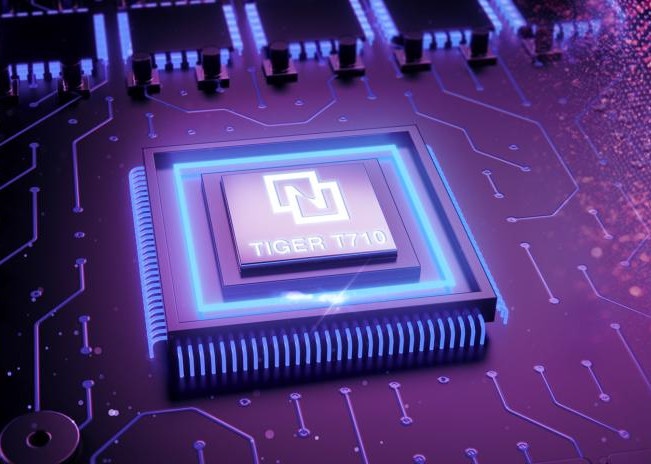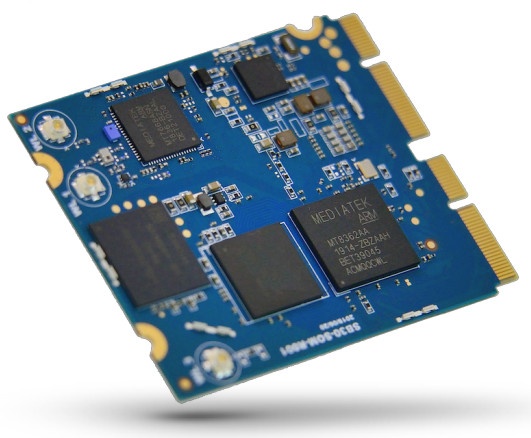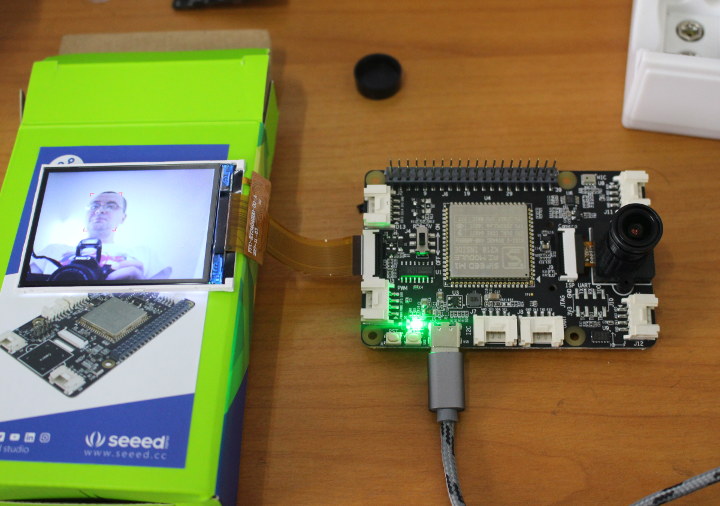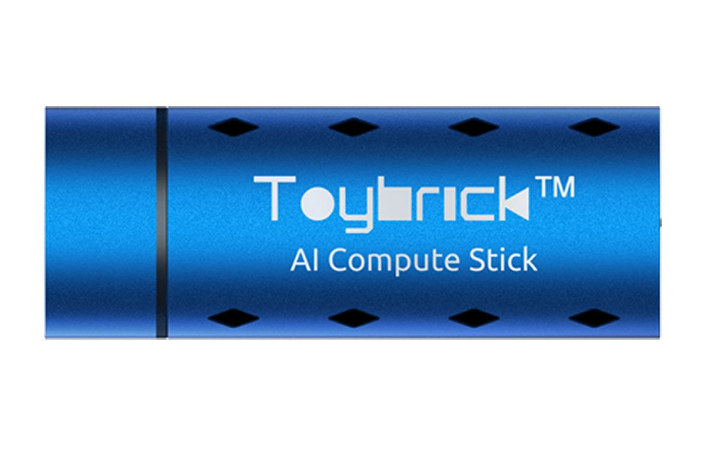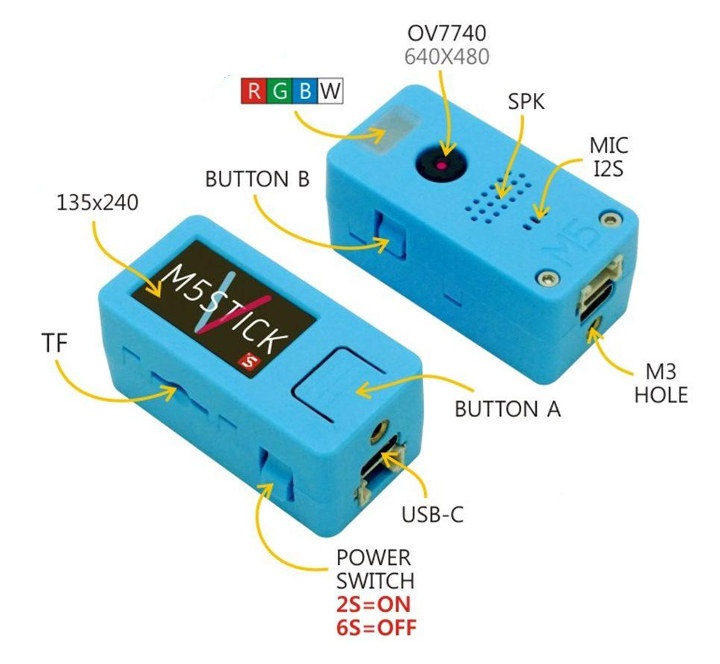Last April, UNISOC introduced Tiger T310 quad-core Cortex-A75/A55 processor for 4G Phone, and the company has now added a new member to their Tiger family with T710 octa-core processor with four Cortex-A75 cores, four Cortex-A55 cores, and a dedicated NPU (Neural-network Processing Unit) for artificial intelligence applications at the edge in the industry, commerce, medical care, home, and education sectors. The company did not setup a product page, so information is really limited. Known features & specifications so far: CPU – 4x Arm Cortex-A75 cores at up to 2.0GHz, 4x Arm Cortex-A55 cores @ 1.8GHz NPU – Heterogeneous dual-core architecture NPU delivering 2.5TOPS per watt GPU – Imagination Technologies PowerVR GM9446 GPU also found in MediaTek Helio P90. The processor supports multiple AI framework formats, including TensorFlow, TensorFlow Lite, Caffe, and multiple AI data formats such as quantization (INT4, INT8, INT16) and floating-point (FP16). Tiger T710 also works with Android […]
MPEG Video Coding for Machines (VCM) is in the Works
A video codec for machines seems like a good topic for the first of April, or an article on the Onion. But based on a recent press release by Gyrfalcon Technology, this may become a real thing as the company partnered with China Telecom, and proposed a new video codec called “Video Coding for machines” (VCM) that provides compression coding for machine vision and human-machine hybrid vision. Apparently a recent study published by Cisco in 2018, humans will become bit players in the “video watching business”, and Machine-to-Machine (M2M) applications will represent the greatest usage of Internet video traffic over the next four years. So the goal of the VCM group will be to establish a new standard that will improve the previous generation video coding and decoding standards such as H.264 (AVC), H.265 (HEVC) and H.266 (VVC). Few details are provided so far, and I can’t find any VCM […]
Innocomm Unveils MediaTek i300/i500 SoMs for IoT and AI Applications
SB30 MTK i300 and SB50 MTK i500 AI IoT Platforms Just announced by Innocomm are the SB30 and the SB50 SoMs carrying the MediaTek i300 and i500 SoC’s, and running either Linux or Android. The rundown on the systems is the MediaTek AIoT processor series has been out for some time, and we reported on the latest SoC in the MediaTek i700 article last July. Innocomm is also known for its NXP-based compute modules such as the i.MX8M Mini driven W15 and i.MX8M powered W10. MediaTek i300 Specs The MediaTek i300 (MT8362) SoC is running a Cortex-A35 power-efficient quad-core processor clocking at 1.5 GHz. The SoC is further equipped with an Imagination PowerVR Series8XE GE8300 GPU. The i300 also integrates a PMIC, an RF chip for 2.4 GHz 802.11/b/g/n as well as Bluetooth 4.0. There is support for the MediaTek MT7668 chipset for 802.11ac (WiFi 5). Rounding out the system […]
Getting Started with Sipeed M1 based Maixduino Board & Grove AI HAT for Raspberry Pi
Last year we discovered Kendryte K210 processor with a RISC-V core and featuring AI accelerators for machine vision and machine hearing. Soon after, Sipeed M1 module was launched with the processor for aroud $10. Then this year we started to get more convenient development board featuring Sipeed M1 module such as Maixduino or Grove AI Hat. Seeed Studio sent me the last two boards for review. So I’ll start by showing the items I received, before showing how to get started with MicroPython and Arduino code. Note that I’ll be using Ubuntu 18.04, but development in Windows is also possible. Unboxing I received two packages with a Maixduino kit, and the other “Grove AI HAT for Edge Computing”. Grove AI HAT for Edge Computing Let’s start with the second. The board is a Raspberry Pi HAT with Sipeed M1 module, a 40-pin Raspberry Pi header, 6 grove connectors, as well […]
Toybrick TB-RK1808 AI Compute Stick is now Available for $86
Last May, we wrote about RK1808 AI Compute Stick, a USB stick with Rockchip RK1808 dual-core Cortex-A35 processor also featuring a 3.0 TOPS neural processing unit to accelerate AI workloads at low power. As I understood it, it was available for purchase, but you had to contact a Rockchip FAE by email in order to get one. Now, you can easily buy one online by getting the Toybrick TB-RK1808 AI Compute Stick on Seeed Studio for $86. Just ignore the “Core i3” in the title, we’ll see why it’s there further below. TB-RK1808 AI Compute Stick specifications: SoC – Rockchip RK1808 dual-core Cortex-A35 processor with NPU AI inference performance – 3 TOPS for INT8, 300 GOPS for INT16, 100 GOPS for FP16 System Memory – 1GB LPDDR Storage – 8GB eMMC flash Host Interface – USB 3.0 type-A port Power Supply – Via USB port Dimensions – 82 x 31 […]
M5Stack M5StickV is a Tiny AI Camera for Maker Projects
I’ve just started to play with Maixduino board based on ESP32 WiSoC and Sipeed M1 module that enables AI tasks such as object detection thanks to built-in AI accelerators found in Kendryte K210 RISC-V processor and noticed references to M5Stack M5StickV in firmware file names. Somehow I never wrote about M5Stack, but the company provides modular ESP32 IoT development boards that can be stacked with various modules to easily and quickly build prototypes. M5StickV is one of those modules and is similar to Maixduino kit with camera and display, minus WiFi + Bluetooth connectivity, except that everything nicely packed into a cute module. M5StickV hardware specifications: SoC – Kendryte K210 dual-core 64-bit RISC-V processor @ 400MHz with dual independent double-precision FPU, 8MB on-chip SRAM, Neural Network Processor (KPU) @ 0.8Tops, Field-Programmable IO Array (FPIOA), and more Storage – 16MB flash, microSD card slot Display -1.14″ SPI display with 240×135 resolution […]
Embedded Linux Conference (ELC) Europe 2019 Schedule – October 28-30
I may have just written about Linaro Connect San Diego 2019 schedule, but there’s another interesting event that will also take place this fall: the Embedded Linux Conference Europe on October 28 -30, 2019 in Lyon, France. The full schedule was also published by the Linux Foundation a few days ago, so I’ll create a virtual schedule to see what interesting topics will be addressed during the 3-day event. Monday, October 28 11:30 – 12:05 – Debian and Yocto Project-Based Long-Term Maintenance Approaches for Embedded Products by Kazuhiro Hayashi, Toshiba & Jan Kiszka, Siemens AG In industrial products, 10+ years maintenance is required, including security fixes, reproducible builds, and continuous system updates. Selecting appropriate base systems and tools is necessary for efficient product development. Debian has been applied to industrial products because of its stability, long-term supports, and powerful tools for packages development. The CIP Project, which provides scalable and […]
Linaro Connect San Diego 2019 Schedule – IoT, AI, Optimizations, Compilers and More
Linaro has recently released the full schedule of Linaro Connect San Diego 2019 that will take place on September 23-27. Even if you can’t attend, it’s always interested to check out the schedule to find out what interesting work is done on Arm Linux, Zephyr OS, and so on. So I’ve created my own virtual schedule with some of the most relevant and interesting sessions of the five-day event. Monday, September 23 14:00 – 14:25 – SAN19-101 Thermal Governors: How to pick the right one by Keerthy Jagadeesh, Software Engineer, Texas Instruments With higher Gigahertz and multiple cores packed in a SoC the need for thermal management for Arm based SoCs gets more and more critical. Thermal governors that define the policy for thermal management play a pivotal role in ensuring thermal safety of the device. Choosing the right one ensures the device performs optimally with in the thermal budget. […]


